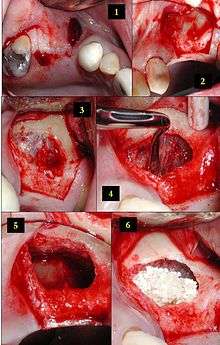Schneiderian membrane

1) Edentulous area of two missing teeth is being prepared for future placement of dental implants with a lateral window sinus lift; incisions into the soft tissue are shown here.
2) The soft tissue is flapped back to expose the underlying lateral wall of the left maxillary sinus.
3) The bone has been removed with a piezoelectric instrument, exposing the underlying Schneiderian membrane, which is the lining of the maxillary sinus cavity.
4) Through careful instrumentation, the membrane is carefully peeled from the inner aspect of the sinus cavity.
5) The membrane has been reflected from the internal aspect of the inferior portion of the sinus cavity; one can now visualize the bony floor of the sinus cavity without its lining membrane (note the triangular ridge of bone within the sinus, known as an Underwood's septum).
6) The newly formed space within the bony cavity of the sinus yet inferior to the intact membrane is grafted with human cadaver allograft bone. The floor of the sinus will now be roughly 10mm or so more superior than it was before, providing enough room to place dental implants into the edentulous site.
2) The soft tissue is flapped back to expose the underlying lateral wall of the left maxillary sinus.
3) The bone has been removed with a piezoelectric instrument, exposing the underlying Schneiderian membrane, which is the lining of the maxillary sinus cavity.
4) Through careful instrumentation, the membrane is carefully peeled from the inner aspect of the sinus cavity.
5) The membrane has been reflected from the internal aspect of the inferior portion of the sinus cavity; one can now visualize the bony floor of the sinus cavity without its lining membrane (note the triangular ridge of bone within the sinus, known as an Underwood's septum).
6) The newly formed space within the bony cavity of the sinus yet inferior to the intact membrane is grafted with human cadaver allograft bone. The floor of the sinus will now be roughly 10mm or so more superior than it was before, providing enough room to place dental implants into the edentulous site.
In anatomy, the Schneiderian membrane is the membranous lining of the maxillary sinus cavity.[1] Microscopically there is a pseudostratified columnar ciliated epithelium that includes goblet cells.
References
- ↑ Boyne, P; James, RA. Grafting of the maxillary sinus floor with autogenous marrow and bone. J Oral Maxillofac Surg 1980;38:113–116.
This article is issued from
Wikipedia.
The text is licensed under Creative Commons - Attribution - Sharealike.
Additional terms may apply for the media files.